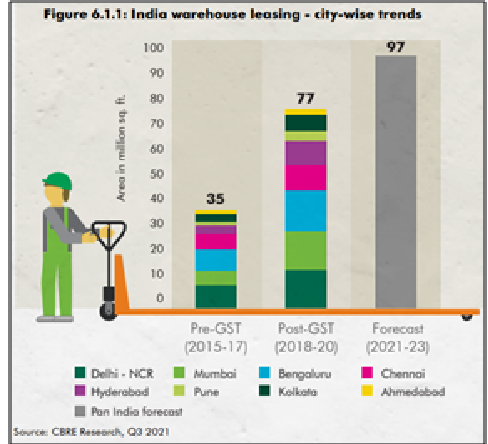Warehouse leasing likely to touch 100 mn sq. ft. over the next three years; e-commerce andthird-party logistics to drive growth: CBRE Report
- India emerging as a preferred investment destination for global manufacturers –especially those deploying a ‘China plus One’ strategyfor diversifying their supply chains
- Favorable demographics, enhanced global investment competitiveness, widespread digitisation, improved Ease of Doing Business ranking and growing trade potential are the five pillars on which India’s manufacturing capabilities rest
- The government’s vision of developing industrial infrastructure – through initiatives such as 11 dedicated industrial corridors, high-speed Dedicated Freight Corridors,Bharatmala, etc. – expected to significantly strengthen the national manufacturing ecosystem
- Warehouse leasing witnessed a historic peak of 32 million sq. ft. in 2019 and is expected to touch nearly 100 million sq. ft. by 2023
- 3PL players accounted for more than 40% of the total warehouse leasing in the post-GST period (2018-20), followed by occupiers from the e-commerce (21%) and engineering &manufacturing (11%) sectors
- Warehouse occupiers to expand their footprint in tier II and III locations,owing to improvements in infrastructure and growth of online retail
CBRE South Asia Pvt. Ltd., India’s leading real estate consulting firm, today announced the findings of its‘INDIA’S INDUSTRIAL & WAREHOUSING SECTOR: TENACIOUS AMIDST THE TURNING TIDE’ report.Against the backdrop of robust growth of manufacturing, e-commerce, and third-party logistics (3PL) sectors, the report highlights how Industrial and Warehousing (I&W)activity has gained momentum over the past few years in India.
The report delves into the dynamics of the current manufacturing ecosystem in India and its improving prospects as an alternative supplychain destination on account of elements such as favorable demographics, relatively low labor costs, and continued thrust on infrastructure improvement and policy reforms. As a result, the business climate in the country has vastly improved, as is evident from the continued jump in India’s Ease of Doing Business rankings. This, in turn, has had a positive impact on the manufacturing sector of the country, which has attracted over USD 121 billion in FDI inflows over the past six years.
Commenting on the announcement, Mr. Anshuman Magazine, Chairman, India & South-East Asia, Middle East & Africa, CBRE, said, “Over the past decade, India has consistently aimed at diversifying from a services-based economy to becoming an alternate manufacturing destination in APAC. As a result, the demand inthe Indian I&W sector has surged, makingit one of the key growth drivers of the real estate industry. With strong government support to ease investment normsthrough attractive tax sops and policy initiatives, we can expectincreased interest from domestic andglobal manufacturers.”
Even before COVID-19, themanufacturing sector was witnessing avisible shift: away from the previouslyestablished destinations towardsalternative hubs. As a result, Indiahas increasingly become an activeplayer in the global manufacturingsupply chain, on the back ofimproved domestic capabilitiesin recent years. This has alsobeen supported by robust government initiatives such as Make inIndia, Aatmanirbhar Bharat, Building India Campaign (through the National Infrastructure Pipeline) as well as policies such as the Production Linked Incentive Scheme, aimed at attracting investments across a diverse mix of industries such as electronics, automotive, pharmaceuticals, textiles and food processing among others.
The report also described the current warehouse leasing scenarioin the country.The warehousing space take-up over the past five years has crossed 100 million sq. ft. cumulatively, with a historic leasing peak of 32 million sq. ft. reached in 2019. 3PL players accounted for more than 40% of the total warehouse leasing in the post-GST period (2018-20), followed by occupiers from the e-commerce (21%) and engineering and manufacturing (11%) sectors. Occupiers across these sectors have startedto increasinglyprefer large-sized spaces to consolidate operations, especially postthe implementation of the GST. Backed by increasing online retaildemand amidst the pandemic,e-commerce and 3PLplayers arefurther expected to lead warehouse leasing over the next few years, the report added.
Following a large-scale expansion in tier I cities, occupiers have also started to expandtheir footprint in tier II and III locations due to improvements in infrastructure and growth of online retail inthese areas.Warehouse supply addition over the past five years also crossed 75 million sq. ft. in the country.
In the current scenario, there isa rising demand for an agile supply chainthat aimsto enable end-to-end control and move from risk mitigation torisk management. As manufacturers focus on increasing CAPEX towards implementing tech in their facility/supply chain, technological advancements such asArtificial Intelligence (AI), Blockchain, Big Data and the Internet of Things (IoT) will ensure that the sector stays resilient in the times to come.

*vrcs
